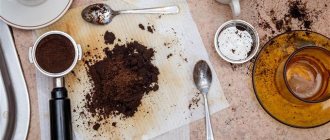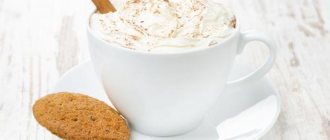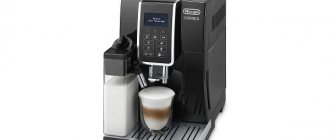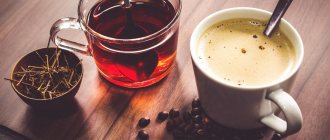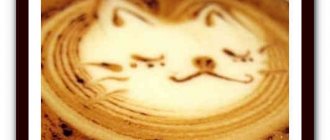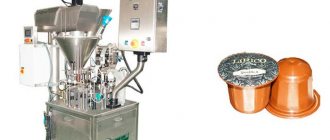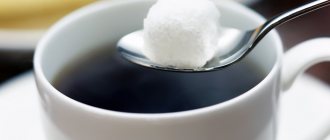Mug or cup: that is the question
A mug is a relatively tall container that can be made of different materials. It is not much larger in size than a glass and is intended for drinking cold or hot drinks: instant coffee, cocoa, tea, compote, milk, juice, kvass, beer. The mug is ideal for quenching thirst, and it is used more often in everyday life. Today, the choice of original mugs is very diverse.
The cup is presented in the form of a low, hollow vessel of small volume, designed for drinking mainly hot coffee, tea, as well as consuming broths and soups.
So what is the difference between a mug and a cup? The main difference is capacity, the ability to hold a certain amount of liquid. The cup volume is usually no more than 200-250 ml, but sometimes 500 ml cups are also found. Meanwhile, a standard mug holds 300-350 ml of water, but there are also half-liter mugs and even liter mugs, for example, for beer. A mug is a more democratic option, and today housewives place this tableware next to the sink, as they use it all the time. The mug is ideal for those who drink large amounts of liquid.
Cups are mainly used for tea and coffee drinking. At the same time, coffee cups in which strong black coffee is prepared have a capacity of only 100 ml of liquid. Tea cups for cocoa, coffee with cream, tea, hot chocolate hold 200 ml. In addition, broth cups, otherwise called tureen cups, are produced, which are used for pureed soup, meat or vegetable broth, soup with chopped herbs and other liquid foods. The volume of such cups is 400-500 milliliters.
It is believed that a drink from a cup should be tasted and savored. This vessel is associated with the leisurely and gradual absorption of food or drink. Mostly the cup is accompanied by a saucer in the same color. They can decorate any dinner party or family celebration, providing a nice end to the meal.
Usually the cup has the shape of a hemisphere, and in a variety of variations, with thin walls. 1 round or irregularly arched handle is attached to the cup. Broth cups generally have 2 opposite handles. Often the handle of the cup is so small and narrow that a finger can barely fit through it. Meanwhile, the rules of good manners state that you should only gracefully hold the cup without sticking your finger into the hole itself.
The standard shape of a mug, as a rule, is close to a cylinder or a truncated cone, and this is influenced by the manufacturer’s imagination and his capabilities. The walls of the mug are quite thick. On the side of the mug there is one wide and quite comfortable handle. It is quite possible to grab it with at least 3 fingers or the whole palm. The set with the mug does not come with a saucer - it is placed directly on the cabinet, table, secretary.
Cups are made mainly from porcelain, earthenware or glass. You can buy a cup with a saucer or a whole set consisting of 8, 10, 12 or more items. Mugs are sold individually and are made from ceramics and plastic, glass and clay, wood and iron, porcelain and aluminum.
Weight of sugar in spoons and glasses
heaping teaspoon of sugar weighs 8–9 grams.
Sugar should be collected carefully to get the largest possible pile.
* Weight tables give the value: 10 g .
A teaspoon of sugar “ with a mound ” weighs 6–6.5 grams.
A heaping tablespoon of sugar weighs 22–24 grams.
To get a spoonful of sugar like this, you need to scoop it deep into the sugar bowl and carefully remove the spoon so as to get the largest possible pile.
* Weight tables show the value: 25 g .
heaped tablespoon of sugar weighs 13–14 grams.
To get this weight, you need to scoop up the sugar and shake off the excess sugar so that this spoon can be comfortably carried across the table at arm's length or from room to room without spilling a crumb.
A full faceted glass of sugar, filled to the brim, weighs 200 grams.
Granulated sugar should be collected level with the top edge of the glass: without a mound. To remove it, you can hold it over the glass with a knife or the handle of a tablespoon.
* Weight tables show the value: 200 g .
How many milliliters are in a standard mug?
Because the industry has achieved high levels of development, this vessel is made from a variety of materials.
The most expensive mugs are porcelain. They are mainly used in reputable restaurants and other establishments. Housewives who have such dishes more often put them on the table when dear guests arrive. By the way, some people collect porcelain mugs. Such products often have original decor in the form of hand painting, cute designs, and prints. The standard capacity of these mugs is mainly 200 milliliters.
Cheap analogues include plain tableware. Since tea, juice, and water will be poured into such dishes, the buyer tries to buy a mug with a fairly large capacity. Manufacturers are focused on producing products that hold 250-400 milliliters. But there are mugs with a volume of 1 liter.
As for metal and plastic mugs, they are used more often in travel, tourism and long trips. They differ from the rest in that they are lightweight and have excellent impact resistance, and are not subject to deformation. Such products have an average volume of 250-300 milliliters. No need to worry about the mug breaking.
Ceramic and glassware are common in household use. Any housewife wants to have cute mugs of original design and shape in her kitchen.
LiveInternetLiveInternet
The menus and recipes of American/English diets use their own, non-metric system of measures.
In English cookbooks, the traditional measure of volume is 1 cup. Cup is a cup.
How many grams are in 1 cup? The volumes of cups are not the same in different cuisines. As a measure of volume, cups are not defined as strictly as spoons. The volume of the cup can vary from 200 to 250 milliliters. If in Australia, Canada, New Zealand a cup can be safely equated to a more familiar glass (250 ml), then in the USA the volume of a cup will be equal to 237 ml, and in the UK, where the so-called imperial system of weights and measures is in use, one imperial cup (imperial cup) is already 284 ml. A metric cup is 250 milliliters, and an American cup is slightly smaller, approximately 236.6 milliliters. In American dietetics, the volume of a cup is 240 milliliters. In Japan, cups are even smaller - only 200 milliliters.
Let's see how many grams of various bulk products can be measured in an American cup.
American measuring cup
- 1/4 cup - 60ml
- 1/3 cup – 75ml
- 1/2 cup – 125ml
- 2/3 cup - 150ml
- 3/4 cup - 175ml
- 1 cup – 250ml
It should be noted that measuring cups, for the most part, come in three volumes - 230ml, 240ml and 250ml... apparently that’s why the cup volume differs on different sites :(. Below I present the information that I found on the Internet - what you and I may need , if we decide to try one of the recipes, I think that many of you have encountered the problem of recalculating weight and volume into native grams and milliliters.
Bulk products
Approximately: 1 cup = 240 ml , or 16 tablespoons. There are 15 ml in 1 tablespoon.
- granulated sugar – 200 g
- powdered sugar – 225 g
- sifted white flour – 125 g
- white rice, uncooked – 185 g
- white rice, cooked – 175 g
- vegetable oil – 224 g
- milk – 245 g
- powdered milk – 68 g
- broccoli – 71 g
- raisins – 165 g
- cocoa powder – 128 g
- yogurt – 245 g
- water – 236 g
The volume of non-liquid ingredients specified in American recipes (if it is more than 2 tablespoons or 1 fluid ounce) is calculated using the following table.
Wheat flour[/td]
| Ingredient weights in grams | |||||||
| Ingredient | 1 cup | 3/4 cup | 2/3 cup | 1/2 cup | 1/3 cup | 1/4 cup | 2 tbsp. |
| 120 gr | 90 gr | 80 gr | 60 gr | 40 gr | 30 gr | 15 g | |
| Sifted wheat flour | 110 gr | 80 gr | 70 gr | 55 gr | 35 gr | 27 g | 13 g |
| Granulated sugar (cane) | 200 gr | 150 gr | 130 gr | 100 gr | 65 gr | 50 gr | 25 gr |
| Confectionery sugar (cane) | 100 gr | 75 gr | 70 gr | 50 gr | 35 gr | 25 gr | 13 g |
| Brown sugar | 180 gr | 135 gr | 120 gr | 90 gr | 60 gr | 45 gr | 23 g |
| Corn flour | 160 gr | 120 gr | 100 gr | 80 gr | 50 gr | 40 gr | 20 gr |
| Corn starch | 120 gr | 90 gr | 80 gr | 60 gr | 40 gr | 30 gr | 15 g |
| Raw oatmeal | 90 gr | 65 gr | 60 gr | 45 gr | 30 gr | 22 gr | 11 g |
| Salt (table) | 300 gr | 230 gr | 200 gr | 150 gr | 100 gr | 75 gr | 40 gr |
| Oil | 240 gr | 180 gr | 160 gr | 120 gr | 80 gr | 60 gr | 30 gr |
| Chopped fruit | 150 gr | 110 gr | 100 gr | 75 gr | 50 gr | 40 gr | 20 gr |
| Nuts (chopped) | 150 gr | 110 gr | 100 gr | 75 gr | 50 gr | 40 gr | 20 gr |
| Nuts (crushed) | 120 gr | 90 gr | 80 gr | 60 gr | 40 gr | 30 gr | 15 g |
| Bread crumbs (fresh) | 60 gr | 45 gr | 40 gr | 30 gr | 20 gr | 15 g | 8 g |
| Bread crumbs (dry) | 150 gr | 110 gr | 100 gr | 75 gr | 50 gr | 40 gr | 20 gr |
| Parmesan cheese (grated) | 90 gr | 65 gr | 60 gr | 45 gr | 30 gr | 22 gr | 11 g |
Liquids in cooking recipes are usually measured by volume. Bulk and dry products in the metric system, on the contrary, are measured by mass.
Liquid products
The following table shows the weight of liquid foods in an American cup:
American system of measures for liquids converted to liters and milliliters:
Gallon (gal), gallon - 4 quarts - 3.8 liters Quart (qt), quart - 2 pints - 0.94 liters Pint (pt), pint - 0.47 liters Ounce (oz), ounce - 29.6 milliliters
British Imperial System of Measures for Liquids Fluid (liquid) ounces (fl oz) = 28.4 ml British quart (quart, qt) = 1.140 l = 2 pints = 4 cups British pint (pt) = 0.570 l = 2 cups British gallon (gallon, gal) = 4.54 l = 4 quarts
For ease of conversion, the value of 1 fluid ounce has been rounded to the nearest 300ml. For more accurate calculations, use the formula 1 Huid oz = 28.4 ml (English system) or 1 Huid oz = 29.5 ml (American system).
American system of measures for liquids Liquid gallon (gal), fluid gallon = 4 quarts or 3.8 liters Liquid quart (qt), fluid quart = 2 pints = 0.94 liters Fluid pint (pt), fluid pint = 0, 47 liters Fluid ounce (oz), fluid ounce = 29.6 milliliters
Other weights
In modern British cookbooks, it is no longer even cups that are used (cups today are marked only for cider and ale), but pounds, ounces and pints.. You may have noticed the abbreviation lb - pound .
Pound (lb, lbs), pound, avoirdupois pound - American, English pound - 454 grams 1 pound - 16 ounces.
- 1 ounce (ounce, oz) – 28.34 grams
- 1 fluid oz – 29.57 ml
- 1 gram – 0.035 ounces
- 1 pound (lb) – 0.454 kg
- 1 kg - 2.2 lbs
Weight conversion table
- 1 ounce - 28 grams
- 4 ounces - 1/4 pound - 113 grams
- 1/3 pound - 150 grams
- 8 ounces - 1/2 pound - 230 grams
- 2/3 lb - 300 grams
- 12 oz - 3/4 lb - 340 grams
- 1 pound - 16 ounces - 450 grams
- 2 pounds - 900 grams
American system of mass units Dry quart (qt), liquid quart = 1.1 liters. Dry pint (pt), dry pint = 0.55 liters.
Abbreviations and English names
| Ounce – ounce – oz Pound – pound – lb Cup – cup – with kg. = kilogram | 1 tbs = teaspoon = teaspoon - 5 ml 1 Tb= = tablespoon = tablespoon - 15 ml 2 cups =2 cups or 1 pint 4 cups (4 cups or 1 quart) |
Teaspoon The volume of a teaspoon is different in different measurement systems. Initially, one teaspoon was a quarter of a tablespoon, then - one third. It is the latter volume that is now used in the American measurement system. This is approximately 4.93 milliliters. In American dietetics, the size of a teaspoon is 5 milliliters. In the UK it is common to use 5.9 millilitres, but some diet guides and cookbooks use 5 millilitres. The size of a teaspoon used in cooking is usually standardized in each country, but different sizes of spoons are used for food.
Tablespoon The volume of a tablespoon also varies depending on the geographic region. So, for example, in America, one tablespoon is three teaspoons, half an ounce, approximately 14.7 milliliters, or 1/16 of an American cup. Tablespoons in the UK, Canada, Japan, South Africa and New Zealand also contain three teaspoons. So, a metric tablespoon is 15 milliliters. A British tablespoon is 17.7 milliliters, if a teaspoon is 5.9, and 15 if a teaspoon is 5 milliliters. Australian tablespoon - ⅔ ounce, 4 teaspoons, or 20 milliliters.
Matches:
1 stick = 113.5 g = 1/4 lb = 4 ounces = 1/2 cup = 8 tablespoons = 14 teaspoons
And in English:
1 stick = 113.5 g = 1/4 lb = 4 oz = 1/2 cup = 8 tablespoons = 14 teaspoons
British volume measures are 20% larger than American ones.
The following table provides data for converting liquid volumes
| Volume conversion (data in table is valid for liquids only) | |
| Specified quantity | Metric equivalent |
| 1 teaspoon | 5 ml |
| 1 tablespoon or 1/2 fl oz | 15 ml |
| 1 fl oz or 1/8 cup | 30 ml |
| 1/4 cup or 2 fl oz | 60 ml |
| 1/3 cup | 80 ml |
| 1/2 cup or 4 fl oz | 120 ml |
| 2/3 cup | 160 ml |
| 3/4 cup or 6 fl oz | 180 ml |
| 1 cup or 8 fluid ounces or half a pint | 240 ml |
| 1 1/2 cups or 12 fl oz | 350 ml |
| 2 cups or 1 pint or 16 fl oz | 475 ml |
| 3 cups or 1 1/2 pints | 700 ml |
| 4 cups or 2 pints or 1 quart | 950 ml |
| 4 quarts or 1 gallon | 3.8 l |
| Note: In cases where there is no need for high data accuracy, you can round the values as follows. 1 cup = 250 ml 1 pint = 500 ml 1 quart = 1 L 1 gallon = 4 L | |
Quarts and Gallons Gallons and quarts also have different sizes, depending on the geographic region where they are used. In the Imperial system of measurement, one gallon is equal to 4.55 liters, and in the American system of measurements - 3.79 liters. Fuel is generally measured in gallons. A quart is equal to a quarter of a gallon and, accordingly, 1.1 liters in the American system, and approximately 1.14 liters in the Imperial system.
Pints are used to measure beer even in countries where the pint is not used to measure other liquids. In the UK, milk and cider are measured in pints. A pint is equal to one-eighth of a gallon. Some other countries in the Commonwealth of Nations and Europe also use pints, but since they depend on the definition of a gallon, and a gallon has a different volume depending on the country, pints are also not the same everywhere. An imperial pint is approximately 568.2 milliliters, and an American pint is 473.2 milliliters.
8 fluid ounces or 235 milliliters liquid cream tube
Fluid ounce An imperial ounce is approximately equal to 0.96 US ounces. Thus, an imperial ounce contains approximately 28.4 milliliters, and an American ounce contains 29.6 milliliters. One US ounce is also approximately equal to six teaspoons, two tablespoons, and one eighth cup.
The most accurate recipes are those where ingredients are measured in grams, pounds or ounces. Because different foods have different weights when measured in cups or spoons. However, you can try to describe the most basic ones.
| American spoons and cups | Grams |
| 1 tbs (teaspoon) | 5 |
| 1 Tb (tablespoon) | 15 |
| 1 cup | 227 |
| 2 cups (2 cups or 1 pint) | 454 |
| 4 cups (4 cups or 1 quart) | 907 |
| 62/3 Tb (6 and 2/3 tablespoons) | 100 |
| 1 cup + 1 Tb (1 cup + 1 tablespoon) | 250 |
| 41/3 cups (4 and 1/3 cups) | 1 liter |
| What do we translate where? | Unit measurements | Qty |
| ounces to grams | ounces | 28,35 |
| grams to ounces | grams | 0,035 |
| liters to quarts | liter | 0,95 |
| quatras to liters | quatras | 1,057 |
| inches to centimeters | inches | 2,54 |
| centimeters to inches | cm | 0,35 |
| Cups | Milliliters | Cups | Milliliters |
| 1/4 | 56 | 1+1/4 | 283 |
| 1/3 | 75 | 1+1/3 | 300 |
| 1/2 | 113 | 1+1/2 | 340 |
| 2/3 | 150 | 1+2/3 | 375 |
| 3/4 | 168 | 1+3/4 | 400 |
| 1 | 227 | 2 | 450 |
With this table you can convert ounces to grams. But keep in mind that the ounces in this table are different from those in the table for liquid products.
| Weight conversion | |
| Specified quantity | Metric equivalent |
| 1 oz | 28 g |
| 4 oz or 1/4 lb | 113 g |
| 1/3 lb | 150 gr |
| 8 ounces or 1/2 pound | 230 gr |
| 2/3 lb | 300 gr |
| 12 oz or 3/4 lb | 340 gr |
| 1 pound or 16 ounces | 450 gr |
| 2 pounds | 900 gr |
| Grams | Ounces |
| 25 | 0,87 |
| 30 | 1,00 |
| 50 | 1,75 |
| 75 | 2,63 |
| 80 | 2,80 |
| 85 | 3,00 |
| 100 | 3,50 |
| 125 | 4,40 |
| 150 | 5,25 |
Oil
Americans sell butter not in packs, but in sticks. An American stick of butter weighs ~113 grams, that is, 4 ounces.
1 cup butter = 2 sticks = 8 oz = 227 g
1/4 cup butter = 55 g 1/3 cup butter = 75 g 1/2 cup butter = 115 g
High-grade flour of Ukrainian or Russian production
1 cup = 5 ounces = 144 g
1/2 cup = 2.5 ounces = 72 g
1/3 cup = 1.7 oz = 48 g
1/4 cup = 1.27 oz = 36 g
1/8 cup = 2 tablespoons = 0.63 ounces = 18 g
Important point! A cup of sifted flour will be approximately 8-10g lighter, measuring 134-136g
Inconsistency
Another important point. Americans estimate the weight of a cup of flour to be 128 g. Our product is heavier. Moreover, I weighed both regular, premium flour and superfine flour. That is, when baking according to American recipes, it is worth taking a spoonful of flour from our cup somewhere so that the weight matches.
Granulated sugar of Ukrainian or Russian production
1 cup = 6.9 oz = 195 g
1/2 cup = 3.5 ounces = 98 g
1/3 cup = 2.3 ounces = 65 g
1/4 cup = 1.7 oz = 49 g
Syrups and honey
Thick syrups and honey are significantly heavier than water, which will affect their weight when measured in cups
2 tbsp. spoons – 43 g
1/4 cup – 85 g
1/3 cup – 113 g
1/2 cup – 170 g
1 cup – 340 g
Useful information:
Pud (pood) is an old Russian unit of measurement. 1 pood = 40 Russian pounds or 16.38 kg.
Table of fat percentage in cream
| Cream | |
| Cream type | Fat content |
| Jersey (English version) | 60% |
| Double (English version) | 48% |
| Heavy (American version) | 40% |
| Whipping | 30-60% |
| Single (English) or Light or Table (American) | 18% |
| Half and Half (American version) | 10-18% |
| Half Cream (English version) | 12% |
Converting Fahrenheit temperature to Celsius temperature:
Based on materials from fanilla.ru, sweetmenu.ru, www.translatorscafe.com, etc.
To be honest, I’m a little confused with the American and English systems of measurements in cooking... The more I look for information, the less clear it becomes to me. The further into the forest, the more firewood...
To help you:
Kitchen cheat sheet
How to dilute acetic acid
The ratio of mass and volume of products
How many milliliters or grams are in a mug?
Often in culinary recipes the measure of food is a mug or cup. By the way, such containers are different in different countries. The mug mentioned in dishes is mainly a standard American vessel that holds 240 ml of liquid. In Europe, New Zealand, Australia, Canada, a regular cup contains 250 ml. The Imperial English mug has a volume of 285 ml. 200 ml mugs are used in Japan. In Russian-speaking countries, and in particular Russia, mugs are very diverse in volume - 180-500 ml. Let's look at the common sizes of these containers.
How many grams are in a 240 ml mug:
- water – 240;
- rice cereal – 230;
- barley – 173;
- buckwheat – 242;
- semolina – 192;
- flour – 154;
- oat flakes – 96;
- powdered sugar – 173;
- sour cream – 247;
- honey – 312;
- tomato paste – 288;
- milk – 247.
Sugar consumption
Let's dive into what sugar is, how much sweets you can eat per day, and what level of sugar consumption is excessive. According to the American Heart Association, there are two types of sugars in our diet:
- Natural sugars that come from foods such as fruits and vegetables.
- Added sugars and artificial sweeteners, such as the little blue, yellow and pink packets found on the coffee counter; white sugar; Brown sugar; and even chemically produced sugars such as high fructose corn syrup. These manufactured sugars are ingredients found in foods such as soft drinks, fruit drinks, candy, cakes, cookies, ice cream, sweetened yogurt, waffles, baked goods and cereals.
Some common names for added sugars or foods with added sugars:
- agave
- Brown sugar
- corn sweeteners
- corn syrup
- fruit juice concentrates
- high fructose corn syrup
- honey (see Harm of honey - in what cases is honey harmful?)
- invert sugar
- malt sugar
- molasses
- raw sugar
- sugar
- sugar molecules ending in “ose” (dextrose, fructose, glucose, lactose, maltose, sucrose)
- syrup
Now that you know about added sugars, what about those that come from natural sources such as fruits? Do they count? Well, sort of. Yes, this is the best choice, but some foods contain high amounts of sugar, so you still need to keep your intake in check - especially if you suffer from diabetes or certain sugar-sensitive diseases.
It's best to eat whole fruits, but choosing the right fruits is still important. A medium-sized orange contains about 12 grams of natural sugar. A small bowl of strawberries contains about half this amount. Dried fruit and whole fruit contain about the same amount of calories and sugar, but dried fruit loses many of its nutritional benefits due to water loss during the drying process.
Oranges and strawberries are low in calories and high in nutrients. They contain 3 grams of fiber, 100% of the daily recommended intake of vitamin C, folic acid, potassium and more.
If you opt for a 500ml bottle of orange flavored soda, here's what you get instead:
- 225 calories
- 0 nutrients
- 60 grams added sugar
Which option sounds more attractive? Soda or orange and strawberry?
Despite the presence of sugar in natural foods, this is a good option because it contains fructose, which is great for energy production. When sugar is removed from foods, there is no dietary fiber left and the nutrient density is greatly reduced. Try to eat natural products - and no, it's not Coca-Cola.
The Obesity Society reports that sugar consumption has increased by more than 30% over the past three decades. In 1977, sugar consumption in developed countries averaged about 228 calories per day, but in 2009-2010 it jumped to 300 calories, and it may now be higher, with children consuming even more. Added to sauces, breads and pastas, in addition to excessive amounts of sweets, drinks and breakfast cereals, these sugars add extra calories to the diet and cause inflammation, illness and more. While this may result in a short-term increase in energy, it significantly reduces the body's supply of essential nutrients.
Research shows that cutting down on sugar intake can make a big difference to our health, especially in relation to type 2 diabetes and obesity. Advocates suggest that by applying restrictive policies, sugar added by manufacturers to food products could be reduced at a rate of 1 percent per year, which could reduce obesity rates by 1.7 percent and the incidence of type 2 diabetes by 21.7 cases per 100,000 people. for 20 years.
The US Centers for Disease Control and Prevention has more detailed statistics on how much sugar people consume:
- From 2011 to 14, youth consumed 143 calories and adults consumed 145 calories from sugary sodas.
- Consumption of such drinks is higher among boys, teenagers or young adults living in low-income families.
- Among adults, soda consumption is higher among men, young adults, or low-income adults.
What are thermal mugs
Particular attention should be paid to thermal mugs, which have become very popular in everyday life. This dish looks like a small thermos. The walls inside are made of ceramic metal. A thermal mug is like a metal glass with a lid that has holes for drinking. The first such mugs were used by the military and travelers. A drink in thermal mugs can maintain its temperature for about 8 hours. They vary in volume - from 250 milliliters to a liter.
The scope of application of thermal mugs has increased many times in our time. Mini thermoses are in great demand among office workers who spend almost the entire working day at a computer or desk, and there is no time left for drinking tea.
In addition to such mini-thermoses, mugs whose outer side can change color based on the temperature of the liquid have become widespread today. When pouring hot tea or coffee, the vessel acquires a design, pattern, or even a photograph if the mug is made to order. When it cools down, the image gradually disappears.
Whatever the mug is in color, shape, number of grams, the main thing is that you like it and be comfortable!
How to measure the amount of flour with a glass?
Sometimes recipes for cooking dishes indicate products in weight units. Not all housewives have kitchen scales at hand, but they want to prepare a delicious dish exactly according to the recipe.
You can measure flour (and other bulk products) with a glass or cup. How do you know if 200 or 300 grams of flour is how many glasses?
It all depends on the volume of the glass.
For 200 ml container:
- 130 grams of flour - 1 cup,
- 200 grams - 1 cup + 1/2 cup,
- 300 grams - 2 cups (full) + 1/3 cup,
- 400 grams - 3 cups.
For a 250 milliliter glass:
- 160 grams of flour - 1 cup,
- 200 grams - 1 cup + 1/4 cup,
- 300 g - 1 cup + 3/4 cup + 1/8 cup,
- 400 g - 2.5 cups.
